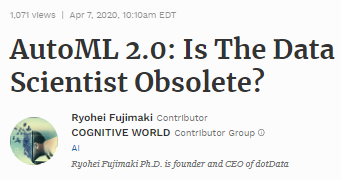The world of AutoML has been proliferating over the past few years – and with a recession looming, the notion of automating the development of AI and Machine Learning is bound to become even more appealing. New platforms are available with increased capabilities and more automation. The advent of AI-powered Feature Engineering – which allows users to discover and create features for data science processing automatically – is enabling a whole new approach to data science that, seemingly, threatens the role of the data scientist. Should data scientists be concerned about these developments? What is the role of the data scientist in an automated process? How do organizations evolve because of this new-found automation?
Important Note
Content Editors rate, curate and regularly update what we believe are the top 11% of all AI resource and good practice examples and is why our content is rated from 90% to 100%. Content rated less than 90% is excluded from this site. All inclusions are vetted by experienced professionals with graduate level data science degrees.
In the broadest sense, any inclusion of content on this site is not an endorsement or recommendation of any service, product or content that may be discussed, recommended, endorsed or affiliated with the content, company or spokesperson. We are a 501(c)3 nonprofit and receive no website advertising monies or direct or indirect compensation for any content or other information on any of our websites. For more information, visit our TOS.







